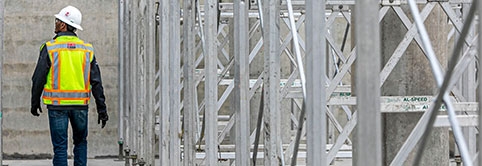Reliable Promises
Introduction to Reliable Promises
In Lean design and construction, trust is a crucial component for ensuring project success. Beyond being an important aspect of respecting people, fostering trust helps the team build confidence and improve communication so that workers understand what is expected of them, and what they can expect from others in return.
Unfortunately, in the current state of the built environment, communication is lacking and promises are frequently left unfulfilled. This breakdown in trust leads to team members pointing fingers when problems occur, which causes a tremendous amount of waste in multiple areas.
So how can we solve this problem and build trust between team members? Through making reliable promises and doing the work to track those promises to ensure we are following through on them.
What is a Reliable Promise?
A reliable promise is a promise made by a performer only after self-assuring that the promisor…
- Is competent or has access to the competence (both skill and wherewithal).
- Has estimated the amount of time the task will take.
- Has blocked all time needed to perform.
- Is freely committing and is not privately doubting ability to achieve the outcome.
- Is prepared to accept any upset that may result from failure to deliver as promised.
Why Promises Are Difficult in the Built Environment
The built environment is, by nature, a very unpredictable industry. Construction projects are huge undertakings that can involve hundreds or even thousands of workers with different ideas, agendas, and roles.
Teams utilizing traditional project delivery systems – the models most are accustomed to – struggle with keeping up strong lines of communication and with aligning goals towards one purpose.
This lack of communication makes promising difficult, since project workers may fear that unknown variables can stop the promise from being delivered upon. Because of this, you’ll often hear people say they’ll “try” to accomplish something, which is not a promise.
Furthermore, there is a surprising deficit in planning and anticipating future problems in the built environment, making promises even more precarious. Nobody wants to put their neck on the line for a promise they don’t feel confident they can deliver – because they haven’t planned that far ahead!
These are all fears that lead to bad promises (or to no promises at all) in the design and construction community, and it’s one reason why people don’t trust promises that are made.
Why Promises Are Necessary in the Built Environment
Construction projects can be thought of as a vast network of promises made between team members and within individual teams.
If you think about it, every individual task that is completed in a project is a promise, whether big or small. Examples include:
- I will complete the lighting layout for the first floor by next Wednesday.
- I will deliver this information to the owner of the project via email by the end of the month
- I will deliver these materials to the construction site on Tuesday.
A promise can be thought of as any commitment that you make with another person or group of people in which everyone involved has a shared purpose. Promises build trust, and by delivering upon a promise, you gain the trust of your coworkers.
When everyone in the team makes promises and keeps them, communication lines are vastly improved, and everyone’s job becomes easier because team members know what to expect.
Elements of a Promise
The Customer
The person making the request.
The Performer
The person fulfilling the request
The Conditions of Satisfaction
Developed by the customer and the performer in tandem, the Conditions of Satisfaction (CoS) make up the language of the promise.
Conditions of Satisfaction are mutually agreed upon, measurable statements that help define what “success” looks like for this project. The CoS outline what conditions must be met in order to call the project a success. The CoS drive the decision-making process for all parties involved throughout the project. Well-developed Cos will include a timeframe, which often is what makes people most uncomfortable about making a commitment.
What Makes a Good Promise?
Not all promises are created equal. When making a promise, it’s important to know what promises are helpful and what promises are unhelpful.
Good promises are…
1. Documented
Promises should be clearly communicated to the team, both verbally and in writing, so that the necessary parties understand what you will accomplish.
2. Planned
Making a promise without a clear understanding of how it will be accomplished is not helpful. The person making the promise needs to do so only when they are certain they will have the means (time and knowledge) to fulfill it.
3. Declarative
Do or do not, there is no try. This is especially true when making promises! Intentions are not promises. “I will…” or “I will if…” are promises. “I hope to…” or “I will try to…” are not promises. Make sure that your promises are full commitments and own the responsibility of making sure that promise is fulfilled.
4. Voluntary
Promises are only valuable when the person makes them voluntarily, knowing that they have a choice in the matter. Promises made under coercion are not helpful. The person making the promise needs to agree to own that responsibility, not feel like the responsibility was forced upon them.
5. Valuable
Is the task you are promising to complete providing value to the project, or is it unnecessary and wasteful? Remember that promises should be made with the CoS in mind and should be worth the time it will take to complete.
How to Track and Keep Promises
In Lean, reliable promises are most associated with the Last Planner System® (LPS®). Promises are a key component to the first three levels of LPS, which includes pull-planning (should), make-ready planning (can), and weekly work planning (will).
When using LPS, team members make promises to one another about work they are planning to accomplish during a set timeframe (usually, this is concerning work to be done before the next daily huddle or weekly work meeting, though promises can also be made further in advance).
During these daily huddles and weekly work meetings, team members review the promises they made during previous conversations and note which ones they were able to complete, and which ones they were not able to complete and why. In some cases, root cause analysis may be necessary to determine the breakdown that prevented the promise from being followed through on.
By making, keeping, and tracking promises diligently, work becomes far more predictable for all parties involved. Team members will understand each other’s responsibilities and will know with a high degree of certainty when and how that work will be completed, allowing them to plan their own work around that.
Learn the Last Planner System
The Lean Construction Institute is committed to transforming the design and construction industry by providing Lean educational resources, conducting field research, and facilitating local and national Lean events. Explore the supplementary resources below to further your understanding of The Last Planner System.
Lean Assessments
How strong is your Lean knowledge? Take a Lean assessment to determine your current state so you have a baseline for improvement. Lean assessments are available for individuals, teams, and organizations alike. Whether you’re new to Lean or are an experienced Lean practitioner, Lean assessments are a great way to get started at LCI!
TAKE ASSESSMENTMore Lean Topics
From 5s to IPD, explore popular Lean design and construction topics below.




